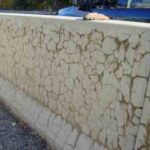The use of silica in concrete is a prime example of how understanding the detailed properties of a material can shift its perceived impact from harmful to beneficial. The Aggregate-Silica Reaction (ASR) has been identified by some scientists as a cause of structural deterioration. Meanwhile, other researchers are leveraging silica to enhance the quality of concrete. So, what’s really going on?
A study was done at the University of Texas to dissect this controversy. Silica fume is added in concrete due to its small grain size that helps to efficiently pack the concrete mass, resulting in higher density. In addition, silica also helps to hydrate the cement and form C-S-H thus helping to increase the concrete’s strength. However, there are impurities in silica fume, i.e. there is a mixture of larger size silica particles which are formed during grinding. It has been reported that such larger size silica are reactive and aggravate ASR. Nonetheless, there is no concluding results because results from various researchers conflicts with each other.
It has been widely accepted that reactive silica exhibits pessimum effect, i.e. the expansion peaks at a certain percentage of silica content rather than increasing linearly. When the ratio of silica to alkali is high, expansion is lowered because the reaction occurs vigorously and the reactants are consumed before the concrete is hardened. On the other hand, when the ratio of silica to alkali is low, there is no sufficient ASR to contribute to total expansion. A sample of experimental result shown below indicates that at silica fume content of about 4% (by weight of cement), the expansion is maximum for both reactive and non-reactive aggregates. This result indicates that silica fume should be used above 10% if we want to make the structure more durable. Addition of lower silica fume can in fact backfire and cause degradation of concrete in a shorter time period instead of adding to its strength.

The verdict is that silica’s impact on concrete hinges on its careful management: while it can cause deterioration through ASR, when used properly, it significantly enhances concrete’s durability and strength. Proper application, particularly in controlling the silica-to-alkali ratio and impurity levels, determines whether silica will be a liability or a valuable asset in construction.
Reference
- Maas, Andrew J., Jason H. Ideker, and Maria C. G. Juenger. “Alkali Silica Reactivity of Agglomerated Silica Fume.” Cement and Concrete Research 37, no. 2 (February 1, 2007): 166–74. https://doi.org/10.1016/j.cemconres.2006.10.011.







